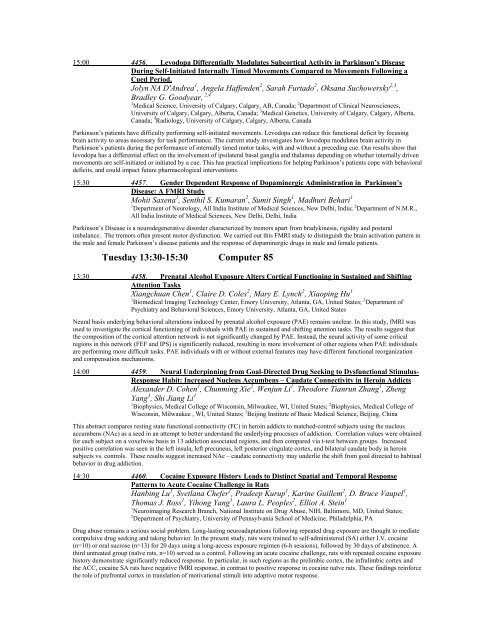Electronic Posters: Neuroimaging - ismrm
Electronic Posters: Neuroimaging - ismrm
Electronic Posters: Neuroimaging - ismrm
Create successful ePaper yourself
Turn your PDF publications into a flip-book with our unique Google optimized e-Paper software.
15:00 4456. Levodopa Differentially Modulates Subcortical Activity in Parkinson’s Disease<br />
During Self-Initiated Internally Timed Movements Compared to Movements Following a<br />
Cued Period.<br />
Jolyn NA D'Andrea 1 , Angela Haffenden 2 , Sarah Furtado 2 , Oksana Suchowersky 2,3 ,<br />
Bradley G. Goodyear, 2,4<br />
1 Medical Science, University of Calgary, Calgary, AB, Canada; 2 Department of Clinical Neurosciences,<br />
University of Calgary, Calgary, Alberta, Canada; 3 Medical Genetics, University of Calgary, Calgary, Alberta,<br />
Canada; 4 Radiology, University of Calgary, Calgary, Alberta, Canada<br />
Parkinson’s patients have difficulty performing self-initiated movements. Levodopa can reduce this functional deficit by focusing<br />
brain activity to areas necessary for task performance. The current study investigates how levodopa modulates brain activity in<br />
Parkinson’s patients during the performance of internally timed motor tasks, with and without a preceding cue. Our results show that<br />
levodopa has a differential effect on the involvement of ipsilateral basal ganglia and thalamus depending on whether internally driven<br />
movements are self-initiated or initiated by a cue. This has practical implications for helping Parkinson’s patients cope with behavioral<br />
deficits, and could impact future pharmacological interventions.<br />
15:30 4457. Gender Dependent Response of Dopaminergic Administration in Parkinson’s<br />
Disease: A FMRI Study<br />
Mohit Saxena 1 , Senthil S. Kumaran 2 , Sumit Singh 1 , Madhuri Behari 1<br />
1 Department of Neurology, All India Institute of Medical Sciences, New Delhi, India; 2 Department of N.M.R.,<br />
All India Institute of Medical Sciences, New Delhi, Delhi, India<br />
Parkinson’s Disease is a neurodegenerative disorder characterized by tremors apart from bradykinesia, rigidity and postural<br />
imbalance. The tremors often present motor dysfunction. We carried out this FMRI study to distinguish the brain activation pattern in<br />
the male and female Parkinson’s disease patients and the response of dopaminergic drugs in male and female patients.<br />
Tuesday 13:30-15:30 Computer 85<br />
13:30 4458. Prenatal Alcohol Exposure Alters Cortical Functioning in Sustained and Shifting<br />
Attention Tasks<br />
Xiangchuan Chen 1 , Claire D. Coles 2 , Mary E. Lynch 2 , Xiaoping Hu 1<br />
1 Biomedical Imaging Technology Center, Emory University, Atlanta, GA, United States; 2 Department of<br />
Psychiatry and Behavioral Sciences, Emory University, Atlanta, GA, United States<br />
Neural basis underlying behavioral alterations induced by prenatal alcohol exposure (PAE) remains unclear. In this study, fMRI was<br />
used to investigate the cortical functioning of individuals with PAE in sustained and shifting attention tasks. The results suggest that<br />
the composition of the cortical attention network is not significantly changed by PAE. Instead, the neural activity of some critical<br />
regions in this network (FEF and IPS) is significantly reduced, resulting in more involvement of other regions when PAE individuals<br />
are performing more difficult tasks. PAE individuals with or without external features may have different functional reorganization<br />
and compensation mechanisms.<br />
14:00 4459. Neural Underpinning from Goal-Directed Drug Seeking to Dysfunctional Stimulus-<br />
Response Habit: Increased Nucleus Accumbens – Caudate Connectivity in Heroin Addicts<br />
Alexander D. Cohen 1 , Chunming Xie 2 , Wenjun Li 1 , Theodore Tianrun Zhang 1 , Zheng<br />
Yang 3 , Shi Jiang Li 1<br />
1 Biophysics, Medical College of Wisconsin, Milwaukee, WI, United States; 2 Biophysics, Medical College of<br />
Wisconsin, Milwaukee , WI, United States; 3 Beijing Institute of Basic Medical Science, Beijing, China<br />
This abstract compares resting state functional connectivity (FC) in heroin addicts to matched-control subjects using the nucleus<br />
accumbens (NAc) as a seed in an attempt to better understand the underlying processes of addiction. Correlation values were obtained<br />
for each subject on a voxelwise basis in 13 addiction associated regions, and then compared via t-test between groups. Increased<br />
positive correlation was seen in the left insula, left precuneus, left posterior cingulate cortex, and bilateral caudate body in heroin<br />
subjects vs. controls. These results suggest increased NAc – caudate connectivity may underlie the shift from goal directed to habitual<br />
behavior in drug addiction.<br />
14:30 4460. Cocaine Exposure History Leads to Distinct Spatial and Temporal Response<br />
Patterns to Acute Cocaine Challenge in Rats<br />
Hanbing Lu 1 , Svetlana Chefer 1 , Pradeep Kurup 1 , Karine Guillem 2 , D. Bruce Vaupel 1 ,<br />
Thomas J. Ross 1 , Yihong Yang 1 , Laura L. Peoples 2 , Elliot A. Stein 1<br />
1 <strong>Neuroimaging</strong> Research Branch, National Institute on Drug Abuse, NIH, Baltimore, MD, United States;<br />
2 Department of Psychiatry, University of Pennsylvania School of Medicine, Philadelphia, PA<br />
Drug abuse remains a serious social problem. Long-lasting neuroadaptations following repeated drug exposure are thought to mediate<br />
compulsive drug seeking and taking behavior. In the present study, rats were trained to self-administered (SA) either I.V. cocaine<br />
(n=10) or oral sucrose (n=13) for 20 days using a long-access exposure regimen (6-h sessions), followed by 30 days of abstinence. A<br />
third untreated group (naïve rats, n=10) served as a control. Following an acute cocaine challenge, rats with repeated cocaine exposure<br />
history demonstrate significantly reduced response. In particular, in such regions as the prelimbic cortex, the infralimbic cortex and<br />
the ACC, cocaine SA rats have negative fMRI response, in contrast to positive response in cocaine naïve rats. These findings reinforce<br />
the role of prefrontal cortex in translation of motivational stimuli into adaptive motor response.
















